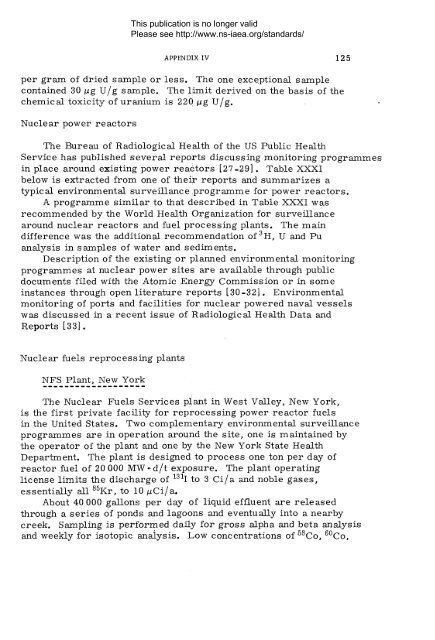Safety_Series_041_1975 - gnssn - International Atomic Energy ...
Safety_Series_041_1975 - gnssn - International Atomic Energy ...
Safety_Series_041_1975 - gnssn - International Atomic Energy ...
You also want an ePaper? Increase the reach of your titles
YUMPU automatically turns print PDFs into web optimized ePapers that Google loves.
This publication is no longer valid<br />
Please see http://www.ns-iaea.org/standards/<br />
APPENDIX IV 1 25<br />
per gram of dried sample or less. The one exceptional sample<br />
contained 30 /jg U /g sample. The lim it derived on the basis of the<br />
chem ical toxicity of uranium is 220 jug U /g.<br />
Nuclear power reactors<br />
The Bureau of Radiological Health of the US Public Health<br />
Service has published several reports discussing monitoring program m es<br />
in place around existing power reactors [27-29] . Table XXXI<br />
below is extracted from one of their reports and sum m arizes a<br />
typical environmental surveillance program m e for power reactors.<br />
A programme sim ilar to that described in Table XXXI was<br />
recommended by the World Health Organization for surveillance<br />
around nuclear reactors and fuel processing plants. The main<br />
difference was the additional recommendation o f 3H, U and Pu<br />
analysis in samples of water and sediments.<br />
Description of the existing or planned environmental monitoring<br />
program m es at nuclear power sites are available through public<br />
documents filed with the <strong>Atomic</strong> <strong>Energy</strong> Com m ission or in some<br />
instances through open literature reports [30-32]. Environmental<br />
monitoring of ports and facilities for nuclear powered naval vessels<br />
was discussed iji a recent issue of Radiological Health Data and<br />
Reports [33].<br />
Nuclear fuels reprocessing plants<br />
NFS Plant, New York<br />
The Nuclear Fuels Services plant in West Valley, New York,<br />
is the first private facility for reprocessing power reactor fuels<br />
in the United States. Two complementary environmental surveillance<br />
program m es are in operation around the site, one is maintained by<br />
the operator of the plant and one by the New York State Health<br />
Department. The plant is designed to process one ton per day of<br />
reactor fuel of 20 000 M W -d /t exposure. The plant operating<br />
license lim its the discharge of 131I to 3 C i/a and noble gases,<br />
essentially all 85Kr, to 10 juCi/a.<br />
About 40 000 gallons per day of liquid effluent are released<br />
through a series of ponds and lagoons and eventually into a nearby<br />
creek. Sampling is perform ed daily for gross alpha and beta analysis<br />
and weekly for isotopic analysis. Low concentrations of 58Co, 60Co,

















